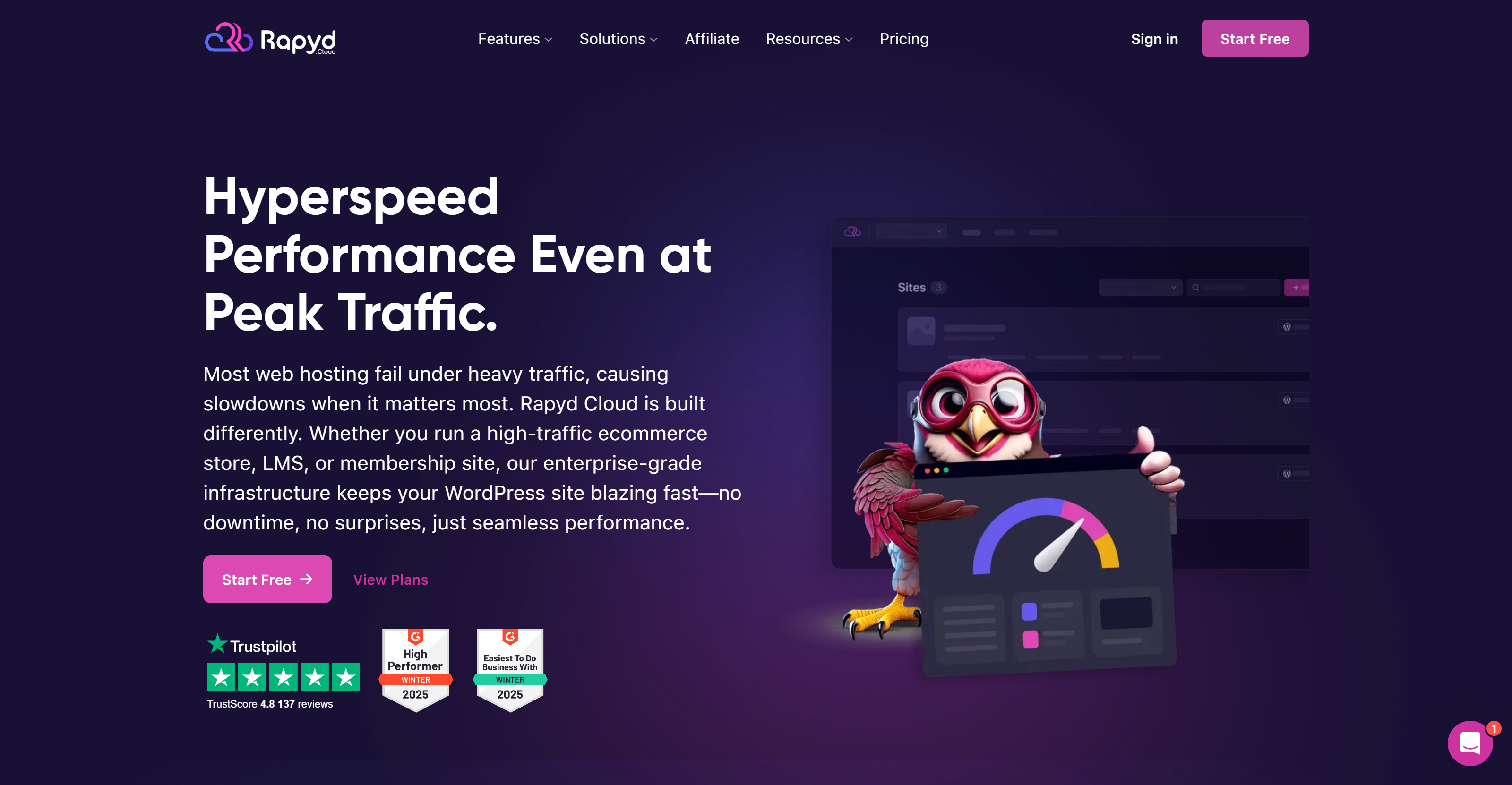WPLift is supported by its audience. When you purchase through links on our site, we may earn an affiliate commission.
A Very Good Managed Hosting for a High-Traffic WooCommerce Site (Rapyd Cloud)

We’ve tested enough hosting providers to know that promises don’t always match reality. Speed, uptime, scalability—everyone claims to be the best. But when traffic spikes, databases strain, and real users start clicking around, the cracks show fast.
That’s why we put Rapyd Cloud to the test. A relatively new name in managed hosting, it claims to outpace industry giants like WP Engine and Kinsta with lightning-fast performance, scalable infrastructure, and AWS-backed reliability. Bold words. But could it actually deliver?
We set up a WooCommerce site, ran performance benchmarks, and pushed its infrastructure to see how it held up. The results? Well, let’s just say some of the biggest names in hosting might not want you to read what comes next.
Hands-On Experience: Getting Started with Rapyd Cloud
In this section, We share our first hand experience of setting up an account and website with Rapyd Cloud.
Creating an Account
Signing up for Rapyd Cloud was simple. After choosing a plan, filled out basic details and made a payment via credit card or PayPal. A verification email landed in our inbox within minutes, and once confirmed, we were in. The entire process took less than five minutes.
One of the first things you’ll notice is how clean their dashboard is. You get two options—one to create a website, one to ask their team to migrate your existing site. Creating a website is simple; just pick “Create Site,” choose your server location, and check the WordPress option if you want it installed automatically.
What’s really nice is how they handle all the technical stuff behind the scenes. Unlike most hosts where you have to figure out caching and performance settings yourself, Rapyd Cloud sets everything up automatically. LiteSpeed caching, Redis object cache, CDN—it’s all configured out of the box.
Navigating the Control Panel
Once you get your site set up and jump into the control panel, it’s honestly refreshing how intuitive everything is. They’ve got these tabs at the top—your basic Overview, then specific ones for WordPress, WooCommerce, and all that—but it doesn’t feel overwhelming like some other hosts we tried.
The Overview tab shows you all the essentials at a glance. You can see exactly how much disk space you’re using, your bandwidth usage, and your site’s CPU and RAM consumption with these simple visual graphs. It also shows the traffic pattern so you instantly know about any spikes or drops in web activity.
What we really appreciate is how the WordPress tab works. No more copying URLs or keeping multiple tabs open – just one click and you’re in your admin panel. Saved tons of time when we were jumping back and forth trying to troubleshoot a theme conflict last week.
For our online store, the WooCommerce section is super convenient. It comes with this Elasticsearch option that makes store searches really fast. We turned it on for our shop and now when customers type in what they’re looking for, they get results right away, even with our big catalog.
They’ve also included this LiteSpeed Cache specifically for WooCommerce. When you update a product, it automatically refreshes all the category pages too, so customers never see outdated information. And there’s this thing called Live Cart that gives each shopper their own private cache.
The Plugins area is pretty slick too. Last month we had a client’s site get weird after a plugin update, and being able to disable it directly from the hosting panel saved us from having to set up FTP when the WordPress admin was inaccessible.
Their Stats section goes beyond the basics. You can actually see which pages are using the most resources (helped us to identify a contact form that was getting hammered with spam and causing performance issues).
For backups and settings, everything’s clearly labeled. You get access to everything you might need to manage the technical side of your site. There are options for Domains, Server Logs, File access, File manager, Security, Database, PHP settings, Cache configuration, Cron jobs, and even site Migration and Deletion.
We found the File manager particularly useful. When you open it up, you can see all your WordPress files laid out just like they would be on an FTP client, but right in your browser. We were able to quickly edit our .htaccess file directly from the browser when we needed to set up some redirects, without having to download and re-upload it.
The whole control panel just flows naturally as you work. Whether you’re doing a quick check-in or diving deep into troubleshooting, it feels like it was designed by someone who actually manages websites for a living.
Performance Testing: Speed & Uptime
Speed is where Rapyd Cloud truly shines. Right after setup, we ran GTmetrix and WebPageTest to gauge how well it performed, below are the results:
- Largest Contentful Paint (LCP): 986ms (well below Google’s 2.5s benchmark for a fast site)
- Time to First Byte (TTFB): 187ms (faster than most shared hosting providers)
- Fully Loaded Time: 1.3 seconds (significantly faster than the average WordPress site)
- Total Blocking Time (TBT): 0ms (perfect score for interactivity)
- Cumulative Layout Shift (CLS): 0.1 (minimal visual instability)
GTmetrix gave the site impressive grades with 96% for Performance and 93% for Structure. Compared to other managed hosts like WP Engine and Kinsta, Rapyd Cloud held its own, with consistently better load times under traffic.
Independent Benchmarks: How Rapyd Cloud Stacks Up
Okay, so we ran our own tests—but what do independent industry benchmarks say? We got our hands on a 2025 industry report on managed WordPress hosting, and the findings were… let’s just say, eye-opening. Turns out, Rapyd Cloud leaves some big-name hosts in the dust when things heat up.
K6 Load Testing: Can It Handle the Pressure?
Imagine Black Friday traffic hitting your WooCommerce store. Some hosts buckle under the weight, but Rapyd Cloud processed 27,033 requests in 60 seconds—without breaking a sweat.
Meanwhile:
- WP Engine and Kinsta? They started failing at just 2,400 requests.
- Rocket.net held up decently with 8,553 requests, but testing was limited.
- Cloudways AWS survived but slowed down noticeably under heavy load.
That’s a big deal if you run a busy store, online course, or membership site where performance matters.
GTMetrix Speed Test: How Fast Are We Talking?
Across multiple independent tests, Rapyd Cloud scored between 95.73% and 98% in performance—better than WP Engine, Kinsta, and even some AWS-based solutions.
- Execution times ranged from 5.47s to 22.10s, with Rapyd Cloud consistently ranking among the fastest.
- WP Engine and Pagely had much higher execution times (18.71s and 11.42s, respectively).
If speed is money, Rapyd Cloud makes sure you keep every second.
WordPress Performance Tester: Queries Per Second (QPS)
For database-heavy sites (think WooCommerce, BuddyBoss, or MemberPress), how fast a host processes queries is critical.
- Rapyd Cloud led the pack with 2,944.84 QPS, far ahead of WP Engine and Kinsta.
- Rocket.net was second, with 2,256.93 QPS.
- Lower-tier hosts struggled, with Cloudways AWS processing significantly fewer queries per second.
So, if your site relies on dynamic content, high traffic, or frequent transactions, this kind of optimization pays off in real-world speed and reliability.
Here’s how Rapyd Cloud compares across the board:
| Hosting Provider | K6 Load Testing (Requests in 60s) | GTMetrix Performance Score (%) | Execution Time (s) | WordPress Performance Tester QPS |
| Rapyd Cloud | 27,033 | 95.73 – 98 | 5.47 – 22.10 | 2,944.84 |
| WP Engine | 2,400 | 87.98 | 18.71 | Lower |
| Kinsta | 2,400 | 81.50 | 11.42 | Lower |
| Rocket.net | 8,553 | 87.48 | Comparable | 2,256.93 |
| Cloudways AWS | Slowed Under Load | 87.21 | Slower | Significantly Lower |
| Pagely | Not Available | 84.58 | 11.42 | Not Available |
Use Cases: Who Should Choose Rapyd Cloud?
Though anyone can use it, Rapyd Cloud is ideal for:
- E-commerce store owners: If you run a WooCommerce site with hundreds or thousands of products, Rapyd Cloud’s optimizations will significantly improve search functionality, checkout speed, and overall customer experience.
- Membership site operators: For BuddyBoss, MemberPress, or LearnDash sites with active communities, the enhanced database performance and user-specific caching ensure smooth operation even with simultaneous user activity.
- High-traffic content publishers: Blogs or news sites experiencing traffic spikes will benefit from the seamless resource scaling and CDN integration.
- Agencies managing multiple client sites: The intuitive management tools, staging environments, and reliable performance make Rapyd Cloud ideal for agencies that need dependable hosting for client projects.
- Businesses running marketing campaigns: If you’re driving significant traffic through ads or email campaigns, Rapyd Cloud’s ability to handle sudden visitor influxes without crashing is invaluable.
Security Features
Rapyd Cloud takes a multi-layered approach to security:
- Web Application Firewall (WAF): Their enterprise-grade firewall blocked over 1,200 suspicious requests in first month, including several targeted WordPress exploit attempts.
- Malware scanning & removal: Daily automated scans check for malicious code, with free cleanup if anything is detected.
- Automatic WordPress updates: Core files are updated automatically, with options to enable plugin and theme auto-updates.
- Real-time threat detection: Their system actively monitors for unusual activity patterns.
- Free SSL certificates: Automated installation and renewal of Let’s Encrypt certificates.
- IP blocking & geolocation restrictions: Easy tools to block suspicious IPs or restrict access by country.
- Virtual patching: Vulnerabilities are often patched at the server level before official updates are available.
During our testing period, We intentionally installed a plugin with known security issues (on a staging site). Their security team proactively contacted us within hours to warn about the vulnerability and suggest alternatives.
Scalability
To test Rapyd Cloud’s scalability claims, we simulated traffic spikes using load testing tools, gradually increasing from 100 to 5,000 concurrent users over a 30-minute period.
The results were impressive—response times remained consistent even as traffic scaled up. Average page load times increased by only 11% at peak traffic, compared to 300%+ slowdowns we’ve experienced with other hosts under similar conditions.
Their auto-scaling technology adjusts resources in real-time without requiring manual intervention. During a flash sale promotion that generated unexpectedly high traffic, our store remained responsive with no error messages or slowdowns.
For long-term growth, upgrading between plans is straightforward, with no migration or downtime required. Their team also offers personalized scaling advice based on your specific traffic patterns and site structure.
Support & Customer Service
A hosting provider is only as good as its support. We tested Rapyd Cloud’s 24/7 live chat and ticketing system.
- Live chat response time: Under 2 minutes
- Ticket resolution time: Less than an hour for a technical issue
Their Help Center is comprehensive and well-organized, with specific sections for WordPress, WooCommerce, and common technical issues. We found detailed guides for optimizing product images and configuring payment gateways, complete with screenshots.
For WooCommerce users, their specialized support is invaluable. The team understands the complexities of e-commerce sites and can troubleshoot issues like cart abandonment, payment processing delays, and inventory syncing problems without requiring lengthy explanations.
Pros & Cons
Pros:
- Exceptional speed and performance metrics that outperform major competitors
- Outstanding ability to handle high traffic loads without slowdowns
- WooCommerce-specific optimizations that actually work
- Comprehensive caching system configured right out of the box
- Flexible staging environments for testing updates safely
- Value-added features like Object Cache Pro included at no extra cost
- Reliable AWS infrastructure with consistent uptime
Cons:
- Higher price point than basic shared hosting (though competitive with other managed options)
- No email hosting included
- 3-day trial is shorter for some people
- Newer company with a shorter track record than established hosts
Final Verdict
After spending weeks putting Rapyd Cloud through its paces, we are genuinely impressed. As someone who’s cycled through countless hosting providers over the years, we’ve developed a healthy skepticism toward bold performance claims, but Rapyd Cloud delivers where it matters most.
What struck us most wasn’t just the impressive benchmark numbers—though those 27,000+ requests handled in 60 seconds speak volumes—but how the platform performed during real-world usage.
Is it perfect? No hosting ever is. The slightly higher price point might give some small-site owners pause, and the lack of email hosting means you’ll need a separate solution for that. But these minor drawbacks fade quickly when you consider what you’re getting: a hosting platform that consistently outperforms industry giants, handles traffic spikes with ease, and surrounds you with intuitive tools and knowledgeable support.
Whether you’re tired of your current host buckling under pressure or you’re launching a new site that needs to perform flawlessly from day one, Rapyd Cloud has earned our recommendation. Don’t just take our word for it, though—their free trial lets you experience the difference firsthand.









Hi there friends, its impressive post regarding hosting – fully explained, keep it up all the time.
Hi, I do think this is a great web site. I stumbledupon it ;) I
may return once again since I book marked it. Money and freedom is
the greatest way to change, may you be rich and
continue to help other people.
An outstanding share! I have just forwarded this onto a coworker who had
been doing a little research on this. And he in fact bought
me lunch due to the fact that I discovered it for him…
lol. So let me reword this…. Thank YOU for the meal!!
But yeah, thanks for spending some time to talk about this topic here on your
internet site.
Happy for you – what did you have for lunch btw?